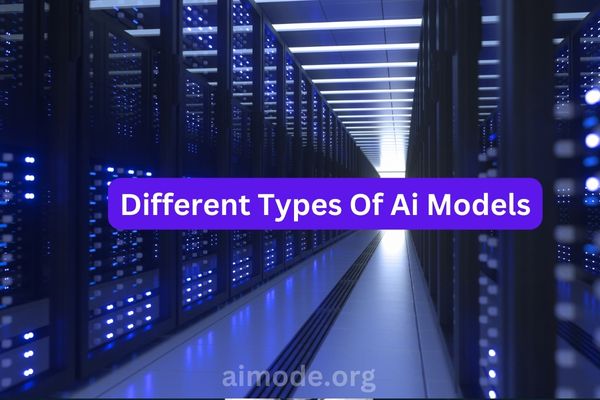Different Types of AI Models: The artificial intelligence (AI) is a multifaceted model that can be used to imitate human cognitive functions. These models may be complex, simple, applied, and scientific, depending upon the policy issue. Before moving forward, it is important to gain insight into AI models and the targeted application spectrum, ranging from image data to natural language processing.

Different algorithms are found in rule-based systems, neural networks, and decision trees which are the most typical instance of this category. Let’s dive into the intricacies of different types of AI models.
Also See: Different AI Types Based on Functionality
Different Types of AI Models In Detail
1. Machine Learning (ML) Models
a. Linear Regression:
Linear regression is a fundamental ML model used for predicting continuous numeric values. It establishes a linear relationship between input features (independent variables) and the target variable (output). The model aims to find the best-fit line that minimizes the error between predicted and actual values. Applications include stock price prediction, sales forecasting, and risk assessment.
b. Logistic Regression:
Unlike linear regression, logistic regression is employed for classification tasks. It predicts the probability of an event occurring (e.g., whether an email is spam or not). The output is binary (yes/no or 0/1), making it suitable for scenarios like fraud detection, medical diagnosis, and sentiment analysis.
Also See: 6 Disadvantages of Artificial Intelligence in Business
2. Deep Learning (DL) Models
a. Convolutional Neural Networks (CNNs):
CNNs excel in image recognition and computer vision tasks. Inspired by the human visual system, they use convolutional layers to detect features (edges, textures, shapes) in images. Applications include facial recognition, object detection, and self-driving cars.
b. Recurrent Neural Networks (RNNs):
RNNs are designed for sequential data, such as time series or natural language. They maintain an internal state (memory) to process sequences. RNNs are used in speech recognition, machine translation, and sentiment analysis.
c. Generative Adversarial Networks (GANs):
GANs consist of two neural networks: a generator and a discriminator. They compete against each other, with the generator creating realistic data (images, text, music) and the discriminator distinguishing real from generated content. GANs are used for image synthesis, style transfer, and data augmentation.
Also See: 16 Potential Benefits Artificial Intelligence in Education
3. AI Levels
a. Artificial Narrow Intelligence (ANI):
ANI refers to specialized AI systems that perform specific tasks exceptionally well. Examples include voice assistants (Siri, Alexa) and recommendation engines. ANI lacks general intelligence and cannot handle diverse tasks.
b. Artificial General Intelligence (AGI):
AGI aims to replicate human-like intelligence. It would possess reasoning abilities, creativity, and adaptability across various domains. Achieving AGI remains a significant challenge.
c. Artificial Super intelligence (ASI):
ASI surpasses human intelligence and can solve complex problems beyond our capabilities. While ASI is theoretical, its potential impact raises ethical and existential questions.
Also See: Future of AI in Education: Changing the Whole World
Conclusion
AI models continue to evolve, driven by research, data availability, and computational power. Understanding these models empowers us to harness AI’s potential for positive change. Whether you’re a developer, researcher, or business leader, staying informed about AI advancements is crucial. So it was all about different types of Ai models, if you liked them then please share them with your friends.